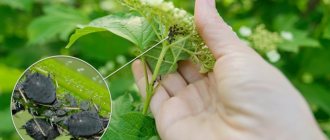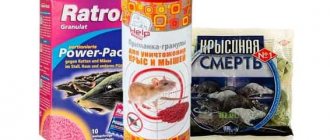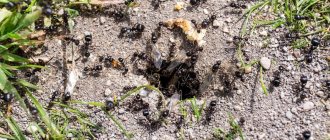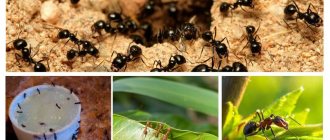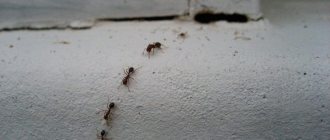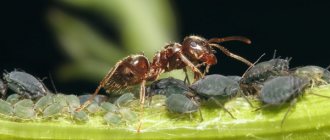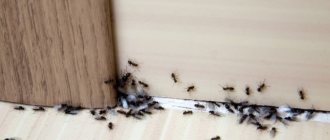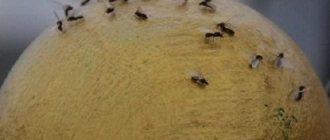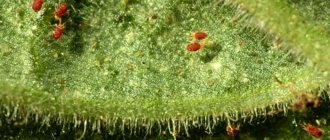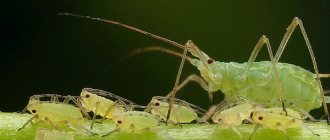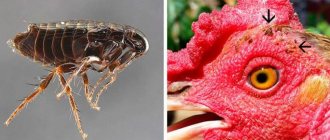The aphid population causes enormous damage to almost all types of plants. These small insects damage all above-ground parts of green spaces and can destroy not only fruit, berry, and vegetable crops, but even indoor potted plants. Aphids feed on plant sap, infect them with various diseases, and also contribute to the spread of other unwanted guests on the site - ants. There are many varieties of aphids, but the appearance of this pest on the site, if timely measures are not taken, can threaten great damage to the garden.
Chemicals are often used to control pests on the site, but traditional methods are no less popular. Chemical preparations are distinguished by their rapid action and high efficiency, but they cannot be used during flowering, fruiting and some time before harvesting. Then folk methods come into play. They are the safest and can be used throughout the entire growing season of fruit and vegetable crops; moreover, the ingredients for medicinal decoctions and infusions can always be found on the site, in the kitchen and in the medicine cabinet.
Extensive colonies of aphids can cause irreparable damage to garden crops
How do aphids appear?
The first thing you need to do if aphids appear on your property is to eliminate the anthills. Ants love to feast on the sweet secretions that aphids leave during their life processes. For the sake of such a “delicacy,” ants even protect these pests from the encroachments of other insects and contribute to the rapid spread of aphids throughout the area.
Thus, it turns out that thriving aphid colonies provide a rapid increase in the ant population. In the fight against ants, you can also use any methods - both folk and chemical, but as long as the homes of these insects are present on the site, all methods of combating aphids will be ineffective.
Garden ants contribute to the spread of aphids throughout the area
Aphids are also attracted to certain plants, for example: legumes, poppies, mallow, tuberous begonias, petunias, nasturtiums, cleomes, and cosmos. But this does not mean that you need to completely give up planting your favorite plants, you just need to take precautions and carry out pest prevention. Folk remedies will help with this.
Signs of a pest
You can detect the pest in the garden by carefully inspecting the trees, since its colonies are visible to the naked eye. Signs of aphids appearing on an apple tree:
- leaves rolled into a tube;
- crooked shoots;
- the formation of dark red spots and swellings on the leaves;
- deformation of tree tops;
- the plants look unhealthy, individual branches and young shoots wither.
When these symptoms appear, immediate treatment of the garden for pests is required.
Traditional methods of fighting aphids
Every self-respecting summer resident should know how to fight aphids using traditional methods. Natural remedies can easily be prepared from ingredients that are often on hand for any gardener or gardener. They are harmless to plants and humans, but have a destructive or repellent effect on harmful insects.
Water
Bushes, trees and plants with tough leaves can be watered with a strong stream from a hose. Water under pressure will knock the aphids off the leaves and stems and the insects will no longer be able to return to their original place. If you use this method together with special traps and ant belts, then in a few approaches you can completely eliminate the aphid population on the plant.
Treatment with soap solution
To do this you will need liquid soap, dish detergent, washing powder and even flea shampoo. You will need 4-5 tbsp. l. soap per 1 liter of water. The resulting solution is thoroughly stirred and all above-ground parts of the affected plant are irrigated.
To prepare the drug, it is best to use products without a sweet aroma, so as not to get the opposite effect. Regular inexpensive soap products, which can be easily found in any hardware store, will do. As a result of spraying with a soap solution, the aphid quickly dies from exhaustion, since the alkali dissolves the waxy layer that serves as its protection from environmental influences.
Laundry or tar soap
This soap, without cosmetic fragrances, not only has a destructive effect due to alkali, but also has a pungent odor that repels “unwanted guests.” To prepare such a solution, you will need 300 g or 300 ml of laundry soap, and only 100 g of tar soap. It is diluted in 10 liters of water and all green parts of plants are treated.
In addition to killing insects, soap helps plants quickly recover from pest attacks; it tightens the affected areas, restores tissue structure and covers the treated parts of the plant with a protective film.
Tar soap is an effective remedy against aphids in the garden
Soap and soda solution
One of the most effective home remedies for aphids. The soap-soda solution has a quick effect and within a day entire colonies of aphids die. To prepare the product you will need:
- A bucket of warm water.
- 10 tbsp. l. soda
- 1/2 or 1/4 bar of soap.
Soap and soda are diluted with water and the green parts of the plant are treated. Indoor flowers and low-growing plants can be wiped with a soft sponge soaked in a solution, and large bushes are best sprayed with a spray bottle.
Ash
The principle of operation of the ash solution is similar. To prepare the product you will need:
- 300 g of ash.
- 40 g of laundry or 20 g of tar soap.
- 10 liters of water.
The ash is sifted through a sieve, poured into water, stirred and placed on the stove. After boiling, cook for 30 minutes, then remove from heat and leave to cool to a comfortable temperature. Add soap to the cooled broth and mix thoroughly until completely dissolved.
A mixture of soap and ash is destructive to aphids
Tobacco infusion
This product can be used throughout the growing season, but when processing during the fruiting period, it is recommended to collect ripe fruits after one week. To prepare the infusion, take 5 liters of hot water, 1 glass of shag, tobacco leaves or tobacco from cigarettes.
The tobacco mixture is brewed and kept for 24 hours, after which the concentrated infusion is filtered and used to treat plants and flowers.
Scented herbal infusions
The smell of some plants repels aphids and other pests. Products based on them can be successfully used for the prevention and treatment of green pets and crops growing in the garden.
- Needles of pine, spruce or other coniferous trees are brewed and left for 10 hours. When the infusion is ready, it is filtered and sprayed on the affected plant. A similar scenario is used to make an infusion of sorrel. The sorrel root is crushed, filled with water and left for 48 hours.
- Dry mustard will repel ants and aphids . You will need 5 liters of water, 100 g of mustard powder and a little soap. All components are mixed and used for spraying. Dry powder can be sprinkled on anthills and near aphid-infested plants.
- Garlic infusion shows its effectiveness in the fight against spider mites, aphids and other pests. To prepare the product, you can use all parts of this plant. They are crushed and placed in a container with water for 1-2 days. You can add a little vegetable oil or soap to the finished infusion and spray it on the affected plant. The product can also be used for watering.
- A mixture of onions, garlic, hot peppers is also infused in water, after which the strained liquid is used for irrigation. Treatment with this product is carried out no more than two times.
- The aroma of citrus fruits is also good at repelling aphids . You will need 40 g of fresh peel of any citrus fruit and 1 liter of boiling water. The infusion is prepared for 3-4 days, after which it is ready for use.
Young succulent leaves are the favorite delicacy of aphids
Potato or tomato tops
To prepare the product, take 4 kg of tops, add 10 liters of water, cover with a lid and leave for 6 hours. After the specified time has passed, the container with the infusion is placed on the fire and boiled until it boils. After the liquid boils, cook it for another 30 minutes and leave to cool. Before use, filter the product, add 50 g of soap and use for spraying.
Flower infusions
Celandine or marigolds are also good for preparing a remedy for annoying aphids. Take 100 g of raw material and add water, put it on fire, bring to a boil and simmer over low heat for about half an hour. After cooling, wipe the leaves with the decoction, irrigate the crown and all infected areas. If marigolds are used as a raw material, then it is better to take the flowers rather than the leaves and stems.
Onion peel infusion
To prepare onion infusion, take a handful of onion husks and pour 250 ml of warm or hot water into it. The composition is allowed to brew for several hours, then it is filtered and the flowers are sprayed with it. Usually, four treatments are enough to completely get rid of aphids.
If you add a little garlic and mustard powder to the onion peel, the effectiveness of the drug will increase. In this case, it is recommended to use the product 2 times a week until the pests disappear.
Traditional methods of combating aphids are effective if used in combination
Essential oils
If the aphid population has not yet reached frightening proportions, then you can use mixtures of essential oils to combat them. These aromatic products are presented in stores in a large assortment. Among them are oils of juniper, rosemary, mint, citrus, cloves, geranium and many other plants. It is enough to add 5 drops of three different strong-smelling oils to a glass of water, stir and apply the product to the leaves and stems of infected plants for a week.
Hydrogen peroxide and vodka
A solution of peroxide and vodka will not only get rid of pests, but will also provide good protection against subsequent infections, and will also give the plant strength for growth and development. To prepare this composition, take 2 tbsp. l. hydrogen peroxide, 2 tbsp. l. vodka and 10 liters of water. All parts of the plant are sprayed with the finished product.
Iodine solution
Iodine is used not only to control pests, but also to additionally feed plants. To prepare the drug, take low-fat milk or whey (1 l), water (9 l) and pharmaceutical iodine (10 drops). Another iodine-based product is also effective: water (10 l), iodine (1 tsp) and soda (2 tbsp). Add a little soap crumbs to the finished solution for durability.
Timely adoption of measures against aphids in the garden plot is the key to a healthy and beautiful harvest.
Vinegar
Table vinegar, essence or apple cider vinegar is diluted in a ratio of 1 tsp/1 liter of water and a little soap is added. To completely get rid of aphids, 2-3 treatments are enough.
Sparkling water
Coca-Cola and Pepsi can be found in many different and unexpected uses. In gardening and plant growing, they have learned to use these drinks as a preventive measure and to get rid of pests. Aphids really don’t like this kind of carbonated water and soon die, but the effect of this “drug” is short-lived. Add a little soap to the drink and apply to the affected areas.
Liquid smoke
The aromatic smoking liquid repels aphids and is a strong poison for them. The affected plants are generously sprayed with liquid smoke, and after a while the aphids will no longer cause trouble, and if you soak sawdust in this mixture and scatter them around the area, you can also solve the problem with ants.
Aphids suck their cell sap from plants, so damaged leaves quickly turn yellow
What harm can an insect cause to an apple tree?
Understanding what type they belong to will help you choose the right weapon for pest control. The main types of garden aphids:
- The red gall aphid got its name because of a feature: the habitat of this species causes swelling on the leaves of the plant - galls. The insect is brown in color and reaches about 2 mm in length.
- Gray aphids attack mature trees. The hemispherical body of the pest is painted dark gray, and the head, tail, mustache and paws are black. The vital activity of aphids occurs on the back side of the leaves, which curls them down in the form of wrinkled burgundy rollers.
- Green aphids are fertile and can produce 12 generations per season in favorable climatic conditions, and in cold regions - half as much, which is also quite a lot. The pest in adulthood reaches no more than 2 mm in length and has a bright green color.
Harmfulness of insects:
- trees slow down;
- fruit buds appear and ripen late;
- tree fruits become small and often fall off;
- weakened shoots are less prepared for winter conditions;
- trees are prone to the appearance of other pests: ants, tree beetles;
- the vulnerability of plants, especially young ones, to fungi and infectious agents appears;
- dust settles on the leaves due to honeydew produced by aphids.
When colonizing plants en masse, gray aphids damage not only the leaves, but also the fruits, as evidenced by small red spots on them.
Prevention of aphids on the site
We learned how to get rid of aphids using folk remedies, but what needs to be done to prevent the harmful insect from appearing on plants again?
In nature, aphids have not only allies, but also natural enemies. Birds and insects are eager to feast on this pest, so it’s worth thinking about how to attract them to your site. To lure birds, you can place feeders, drinking bowls, nests and houses around the perimeter.
Insects that feed on aphids include: ladybugs and their larvae, hoverflies, ground beetles, earwigs, ichneumon beetles, surfflies, wasps, bed bugs, and lacewings.
These insects are also quite easy to attract. For example, you can create a “cozy environment” for earwigs by scattering wood shavings on paths or mulching plants with it. Hoverflies love flowering daisies, lacewings love ferns, and ground beetles love amaranth. To attract ladybugs, carrots and parsley are planted around the area.
The fight against aphids will be successful if you approach the matter responsibly
Some crops have a repellent effect on aphids. They can be planted in garden beds and combined with flowers in flower beds. Aphids do not like the smell of: garlic, marigold, chamomile-pyrethrum, lavender, basil, mint, coriander, mustard, fennel, onion, wormwood, conifers.
Many of these crops have practical applications, and not a single garden can do without some. Others can be used to create spectacular compositions.
Recommendations for using natural aphid repellents
There are a lot of effective methods of combating aphids. The main rule for using any means, both chemical and natural, is to use them wisely. There are several nuances to using natural pest repellents:
- Few traditional methods give instant results. You will have to carry out from three to ten procedures with a frequency of 1-2 times a week. Recipes must be alternated.
- The treatment is carried out only in the evening and special attention is paid to the lower surface of the leaf plates. At the very beginning of the growing season, it is better to use chemicals, and at a later date, before and after harvesting, use softer and harmless natural products.
- Folk remedies are appropriate only on small personal plots. They are not used in agricultural production conditions.
If after using your own preparations the insects do not disappear or the situation worsens, then it is better not to delay and use insecticides. On store shelves you can find biological products that have a milder effect and do not harm fruit and vegetable crops, but cause great damage to aphids and other harmful insects.
If after one treatment the aphids have not disappeared from the leaves, the procedure should be repeated at least one more time.
When using traditional methods, you can get rid of not only pests, but also various fungi and rot. They have an antiseptic effect and at the same time serve as additional nutrition. But you need to use such drugs with caution, wear a mask and gloves, and wash your hands and equipment thoroughly after handling. To prevent aphids from returning, it is necessary to simultaneously treat all adjacent areas.
Author of the article: Kamenkov Igor Dmitrievich
- Related Posts
- Midges in the house: folk methods of fighting that will help you get rid of them forever
- The cabbage leaves have turned red, what to do in this situation, how to deal with the problem
- Valerian will help against cabbage pests: tested by myself
« Previous entry
Development cycle, reproduction and distribution
In late autumn, aphids leave clutches of eggs in fallen leaves, uncollected dried weeds, at the roots of trees and in the axils of the bark, which are successfully preserved throughout the winter. In the spring, larvae are born from the eggs, which begin to feed on the juice of young leaves and buds during flowering, growing into adults.
Within a month, aphids are capable of occupying several hundred square meters of land, migrating using their wings from one garden to another, from vegetables to trees. When developing, aphids secrete a sweetish, sticky white mass, attracting a huge number of ants, which then guard the aphids all summer and spread them to neighboring plants. Green aphids behave almost the same way. During the season, several cycles of development of new generations of females occur.
The main victims of aphid attacks are:
- Coniferous trees - pine, cedar, spruce. By damaging young needles, by the beginning of summer, aphids leave deformed yellow needles on the branches with a white air coating in which new larvae are hidden.
- Fruit trees - cherry, viburnum, sweet cherry. Literally a week later, massive black dots appear on the leaves and shoots, devouring the trees during the flowering period.
- Vegetables - cucumbers, tomatoes, beets, peppers and even sorrel and dill. The black-gray shades of the aphid body can be easily seen on trunks and branches, at the base of ovaries and leaves.
- Berries, shrubs and flowers - jasmine, strawberries and wild strawberries are the favorite delicacies of black aphids. Signs of the lesion are visual deformities in forms covered with sticky dew.
